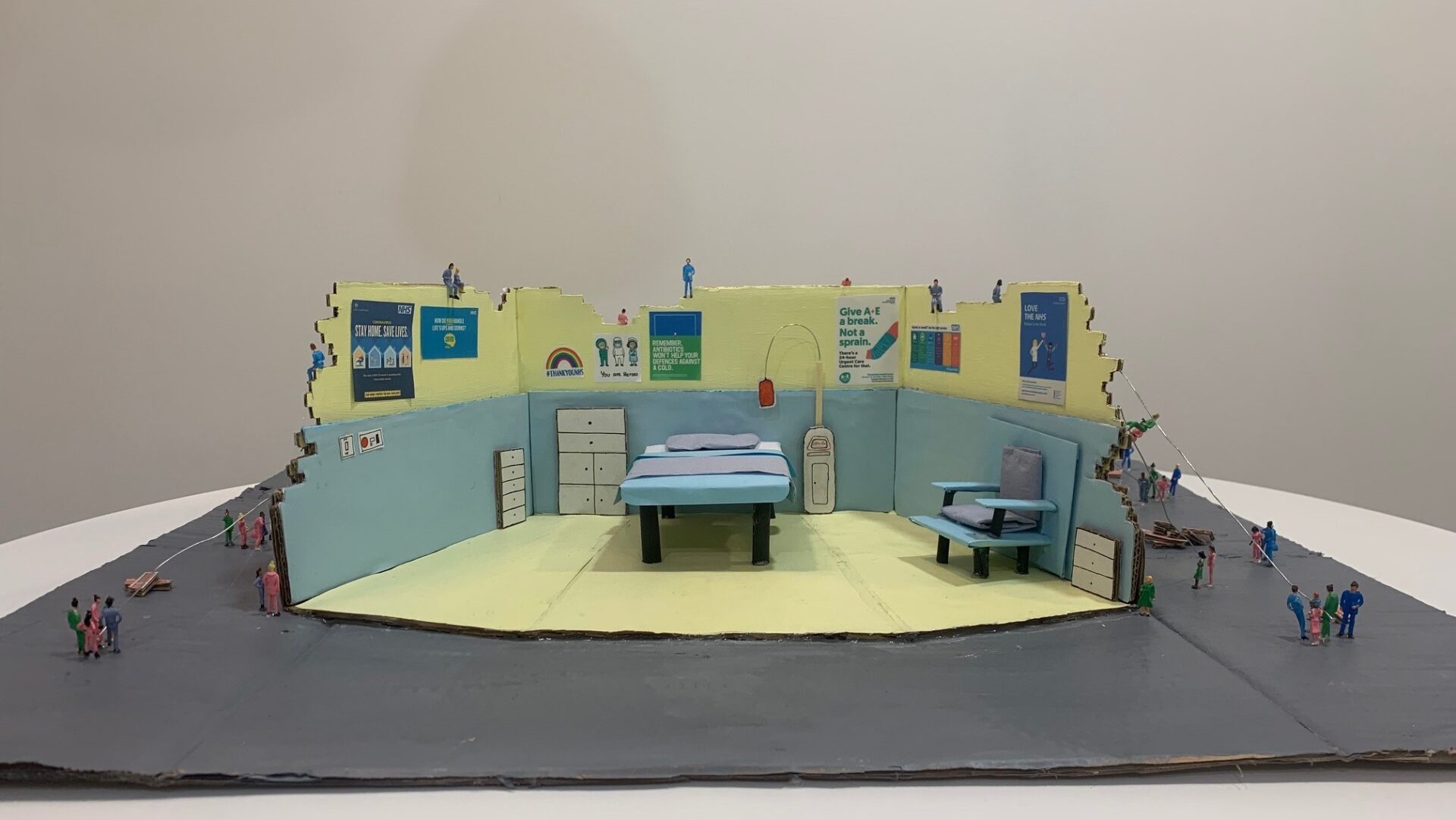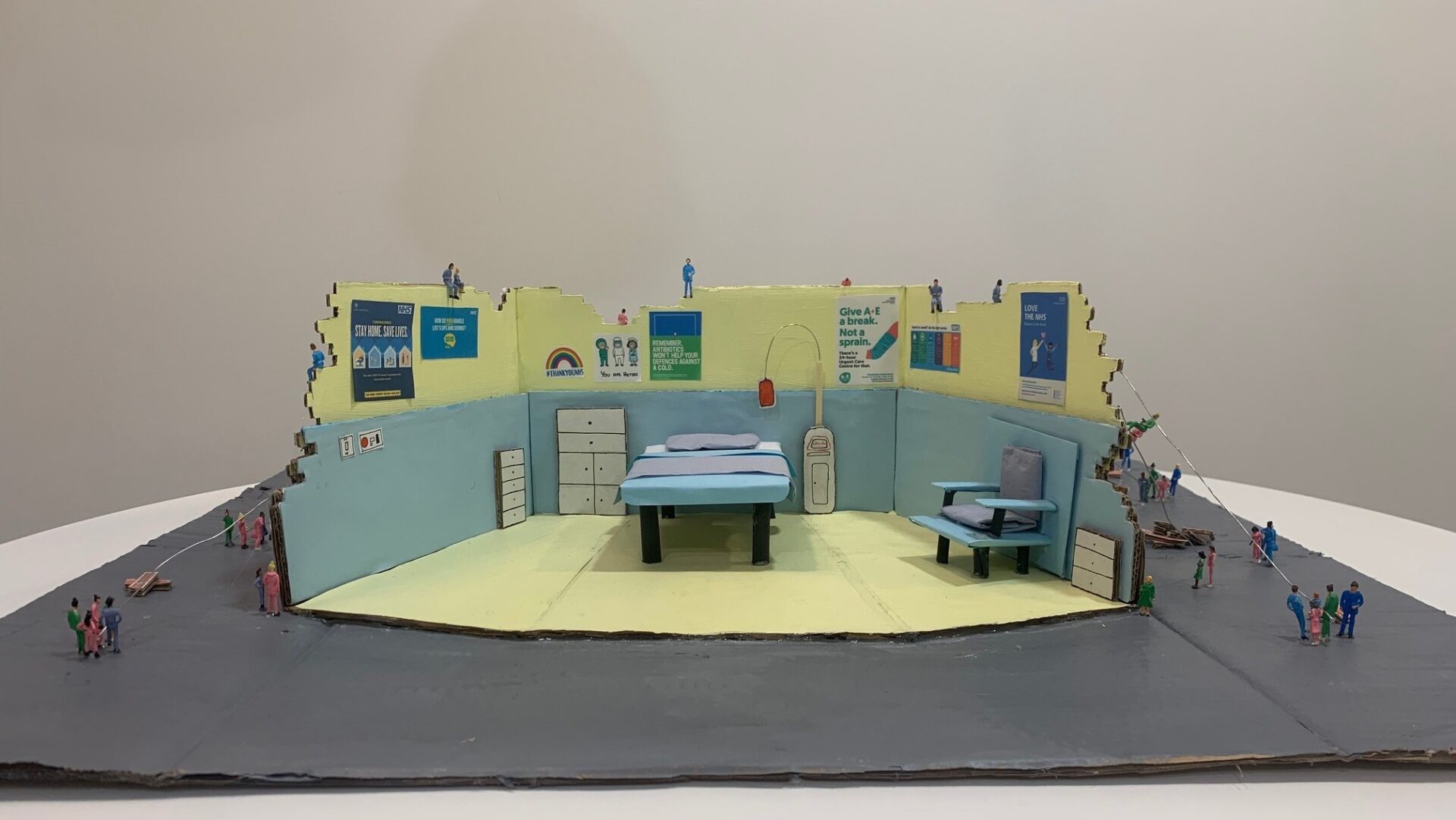‘The NHS is the closest thing the English have to a religion’
“The NHS is the closest thing the English have to a religion” Nigel Lawson 1992
Our project was inspired by the lecture ‘The NHS today’. This lecture enticed us to delve deeper and explore the challenges faced by the NHS as while these struggles are often overlooked by the public, as future doctors, we will ultimately be confronted by them during our careers.
We decided to display our interpretation of what constitutes the NHS and, most importantly, our views on its sustainability.
On a literal level, this model demonstrates NHS staff working together, tirelessly, to hold up the walls of a hospital room. On a more metaphorical level, it is representative of the modern day NHS as a whole, shining a light on the workers who are at the heart of this crumbling system.
The NHS is built on the toil of its workers, an intricate network of people all contributing different skills. The variety of hand-painted figures represents the different roles of staff all working together, to keep the NHS running. We have painted them in scrubs of varying colours to give a sense of uniformity but also to exhibit a feeling of anonymity, since many patients in hospitals are not aware of all of those behind the scenes who have contributed to their care. The tiny scale of the workers in comparison to the hospital room reflects the power system that is the NHS, with the patients at the centre of its values. We also wanted the observer to almost miss noticing that the workers were there at first glance – to represent how, without proper inspection, one would consider the healthcare system to be functioning normally in our model. Patient care is essentially the nucleus of the NHS but sometimes, due to many challenges faced by staff, it can be at the expense of the workers’ good health as they struggle to keep these care systems in place.
The damage to the building and bricks lying around speaks as a metaphor for the never-ending cuts and challenges that the NHS faces; the challenges that undermine the core purpose of the NHS and that ultimately chip away at the communities this system was set to serve.
These small, model people are working together to hold up the walls of the hospital room despite all trials, bringing us to our main message: The NHS is worshipped by the public and this is encouraged by the government however the workers require immeasurably more support if this system is to be maintained. In the design of the building, adoration of the NHS is evident in the graffiti on the outside of the walls. The posters specially chosen to showcase the pride the general public has in the free healthcare system, so much so, that they can overlook the damage being done to it. Yet, while the public support does not go unnoticed, the workers still remain under constant pressure trying to ‘hold up’ the walls. The extent of the precocity of the situation often goes unseen by the patients themselves, with the thin wires holding up the walls of the bright and airy hospital.
From the hospital room itself, the outside struggle is concealed and the vast number of people working together to provide quality care is not only hidden from the patient but also immeasurable. The fact that the walls are coming down faster than they can be built back up, is an acknowledgement of the 1% pay rise, staff shortages and lack of resources that affect our NHS. These challenges are accumulating faster than they are being resolved and this imbalance furthers the strain that the system is under.
Above all, the model symbolises the unsustainability of the system, exacerbated in recent times by the pandemic. We feel, as young adults and future healthcare professionals, it is essential to consider how much longer this system can remain intact before it falls completely into the world of privatised healthcare. If we do not address these issues, and hold those in power accountable, it will soon not only be the NHS workers that suffer, but the public too.
Tabitha Macpherson Jorgenson, Emily Kelly , Rosie Norris, Dasha Jevsejenko and Maham Asif
Comments
Add legacy comments here
2 Comments
Submit a Comment


I’ve spent the last year working for the NHS. While my friends who went straight to university were partying, moving out and making friends. I was working 13 hour shifts, being attacked, over worked and spending everyday dealing with a mix of patients and relatives. Neuro patients are notoriously difficult to work with, and I can definitely attest to this. While the staff on the ward were working hard everyday to look after our patients it felt like everything around us was against us. Senior staff giving us double the amount of 1:1s then the staff we had, the canteen closing at random times throughout the day, lots of small things that really break you down. For me this piece really demonstrates this feeling that no matter how hard you work the NHS is falling down around you quicker then it can be built back up. The piece acknowledges the importance of all staff in the hospital through the different uniforms and demonstrates the team effort that goes into keeping the NHS afloat. The crumbling walls literally represents the poor and often unfit hospitals but also the idea that the NHS is past breaking point and no matter how hard the ward staff work bigger changes need to be made. However, the teams of individuals working together really encapsulates the different teams in the hospital, and how without a good support network and team around you, it would fall down.
The choice to have so many figures building up just one hospital room highlights the dedication that the NHS staff put into each patient. I think that speaks to the ethos of the NHS, where the patient is at the heart of everything it does, and was a smart artistic decision.